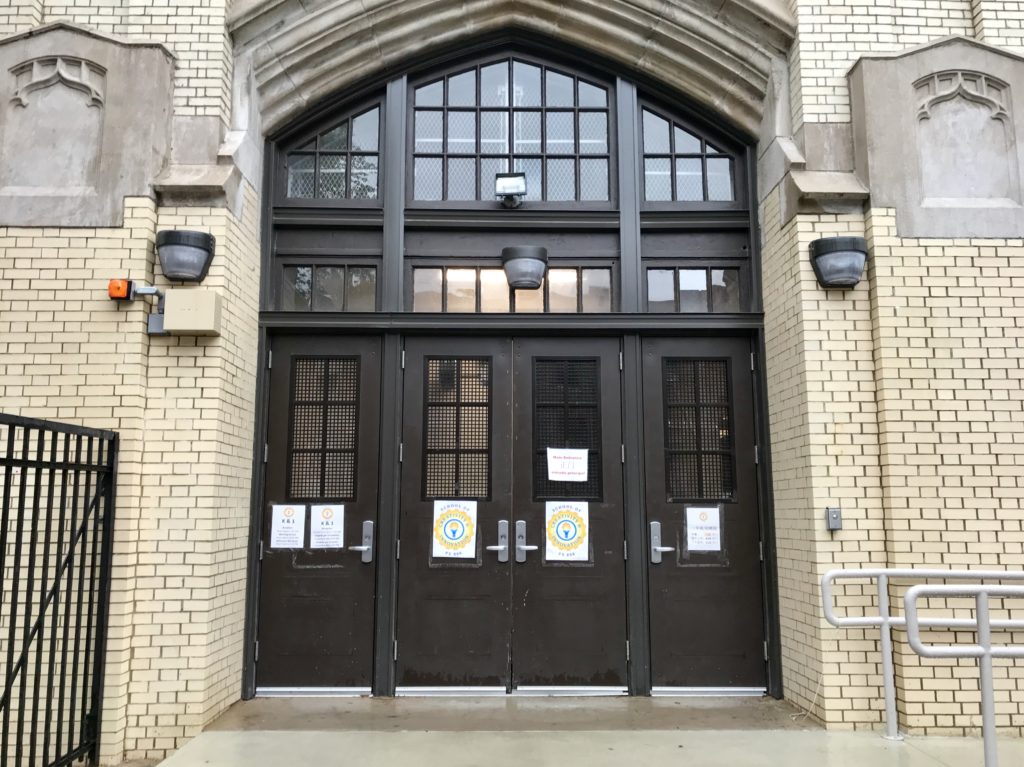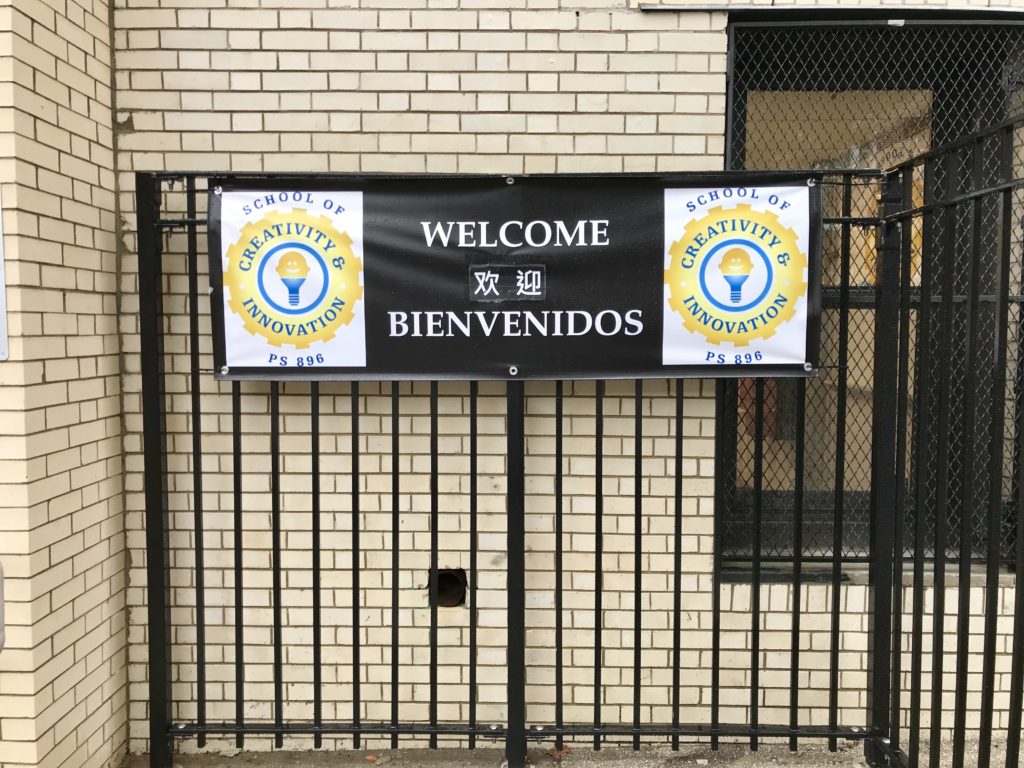
Jinlan Lai’s six-year-old daughter, who returned to PS 896, The School of Creativity and Innovation, in September as a first-grader, comes home with assignments that Lai thinks are easier than what she had last year, in kindergarten. “She doesn’t put any thought into it,” Lai said.
What’s going on? Unlike the other overcrowded elementary schools in Sunset Park, The School of Creativity and Innovation has low enrollment in first grade. With only 12 students in first grade this semester, the school brought together kindergarteners and first-graders, forming a combination class.
Will Mantell, a spokesperson for the Department of Education, says combination classes are not uncommon as a way to coordinate resources in public schools. Anita Skop, Superintendent of School District 15, which encompasses P.S. 896, says that even though the combined class is an anomaly, the children get extra support and individualized attention in such a class that they wouldn’t get anywhere else. “They’re being held to the first-grade standard and getting what first-graders need and even more so,” she said.
But parents are concerned. Hui Huang, 36, worries that her daughter won’t be able to catch up in the future. “First-graders should learn first grade courses. How can you put them together with kindergarteners?”
Another parent, Wendy You, 32, thinks that the combination class is also a burden for teachers, who have to teach two groups simultaneously. “I’m afraid it’s very tiring,” she said.
So how did all of this happen — and in a school district burdened with overcrowding?
It’s complicated. Back in January 2018, school officials announced an ambitious plan to alleviate overcrowding at two other schools — P.S. 169 and P.S. 94 in Sunset Park — by transforming a former Catholic school, St. Agatha, into a public school to be named P.S. 896, The School of Creativity and Innovation.
Schools in Sunset Park have historically been extremely overcrowded, and they still are. In the 2018/2019 school year, elementary schools in the neighborhood were at about 123 percent capacity on average, with the most crowded school, P.S. 172, reaching 155 percent capacity, according to the Enrollment, Capacity, and Utilization Report by the Department of Education.
A new school with more student space was welcome news in the community. “For the first time in a long time, there will be space in Sunset Park,” Skop said during a Community Education Council District 15 meeting in January 2018.
Designed as an “overflow” site to help ease the overcrowding in Sunset Park, P.S. 896 was not open to the public during its first year and only accepted overflow students from P.S. 94 and P.S. 169, so students wouldn’t have to attend P.S. 124, another school on the western edge of Park Slope.
But the students didn’t come, at least not to any great extent. The mechanism didn’t garner many students for P.S. 896. According to Skop, the school had low enrollment because there were “few” overflow students last year, due to a decline in Sunset Park’s population.
Yet both schools that were to send overflow students, P.S. 94 and P.S. 169, were at 130 percent capacity approximately, which translates to some 600 students. But as Skop explained, a school doesn’t have to designate students for overflow as long as the school decides it still has space to accommodate its students.
Families whose kids were sent to P.S. 896 were notified by mail. Lai, You, and Huang, got a letter from the Department of Education assigning their children to kindergarten in P.S. 896 in the summer of 2018 — a surprise to them, since they had not applied to the school. The school was still under construction when Huang visited it, after she was informed of her daughter’s admission interview.
Another 27 kindergarten students were admitted to the school by the time the new semester began in September 2018 — far fewer than originally planned: 75 to 100 kindergarten kids. Whatever the plan, P.S. 896 ended up with 38 students in the 2018-2019 school year — 30 in kindergarten and eight in Pre-K.
One year later, P.S. 896 opened to the public as a non-zoned school with an aim to “serve the whole community.” Families across School District 15 could apply for it, as Skop explained in a meeting of the district’s Community Education Council in April 2018. Unlike a zoned school, a non-zoned school has fewer geographical restrictions, since it admits all students in its school district.
P.S. 896 gained a “significant numbers of kids” for a regular kindergarten this year, said Skop.
But only 19 students registered for first grade, including 12 Chinese-speaking students and seven Spanish-speaking students. Neither group met the minimum number of students required to start a dual language program.

P.S. 896 then offered parents two choices, discussed at public meetings: give up dual language programs, so the 19 kids can form a single class, or accept a combination class with kindergarteners.
It was not an easy decision. Huang knew which way she leaned: “I would rather choose one language,” said Huang. “I don’t want them to put first-graders together with kindergarteners.”
But the choice was made for them. Some parents compromised and agreed to give up bilingual education, only to find that seven students had transferred to other schools before the new semester. With only 12 first-graders left, the only option was a combination class.
The kids will remain in a combination class until more incoming students fill the gap. Ruth Rivera-Rodriguez, principal of P.S. 896, told parents that she couldn’t advertise and recruit students from other schools after the school year began, according to Huang. The parents have been hesitant to endorse the school to friends and relatives when first-graders might still have joined classes with kindergarteners.
Education activists in Sunset Park blame the low enrollment on P.S. 896’s lack of publicity in the community. An organizer for Voces Ciudadnas, a non-profit that offers popular education programming and encourages civic dialogue in Sunset Park, says some charter schools market themselves in the community with T-shirts and banners. “None of that happened,” he said, referring to P.S. 896.
Skop disagreed. She says there was “a lot of outreach” done for the school because initially some people didn’t know it was transformed into a public school, and parents weren’t aware that they could enroll their kids. She admits the first year was “very difficult” since the school had a late opening and by the time it outreached to the community, parents had already registered kids elsewhere.
The organizer, who spoke on the condition of anonymity because he’s an employee of the Department of Education, also points out that the school doesn’t have a geographic zone where it takes students from, another factor that makes enrollment a challenge.
Would zoning the school have helped increase attendance? Skop discussed the school’s rezoning plan in Community Education Council District 15’s special session meeting in April 2018. Meeting minutes show that she elected not to zone because “it would have been a very small zone” that covered only six blocks, and there was no time to consider doing a rezoning.
Julio Peña III, chair of the Education/Youth Committee on Community Board 7, also holds lack of promotion and the school’s non-zoned status accountable for the low enrollment at P.S. 896. He says he is writing a letter to the Department of Education to inquire about the combination class at P.S. 896.
Skop says she welcomes parents to make their concerns heard and is willing to have open discussion with them.
Meanwhile, Lai, Huang, and You are all considering transferring their kids to other public schools as early as next semester. They say they don’t want their kids to be educated in a combination class in higher grades, if low enrollment continues.
“Which parent would think this is fair?” asked Lai, “No parent would be willing to do this.”

Leave a Reply